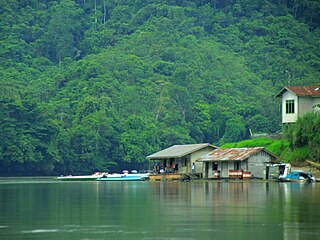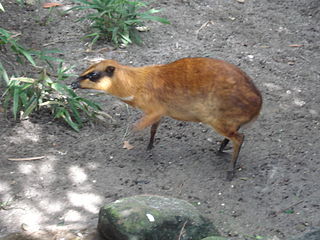Related Research Articles

Borneo is the third-largest island in the world, with an area of 748,168 km2 (288,869 sq mi). Situated at the geographic centre of Maritime Southeast Asia, it is one of the Greater Sunda Islands, located north of Java, west of Sulawesi, and east of Sumatra.

East Malaysia, or the Borneo States, also known as Malaysian Borneo, is the part of Malaysia on and near the island of Borneo, the world's third-largest island. East Malaysia comprises the states of Sabah, Sarawak, and the Federal Territory of Labuan. The small independent nation of Brunei comprises two enclaves in Sarawak. To the south and southeast is the Indonesian portion of Borneo, Kalimantan. East Malaysia lies to the east of Peninsular Malaysia, the part of the country on the Malay Peninsula. The two are separated by the South China Sea.

The geography of Malaysia includes both the physical and the human geography of Malaysia, a Southeast Asian country made up of two major landmasses separated by water—Peninsular Malaysia to the west and East Malaysia to the east—and numerous smaller islands that surround those landmasses. Peninsular Malaysia is on the southernmost part of the Malay Peninsula, south of Thailand, north of Singapore and east of the Indonesian island of Sumatra; East Malaysia comprises most of the northern part of Borneo, and shares land borders with Brunei to the north and Indonesian Borneo to the south.

The Indonesia–Malaysia confrontation or Borneo confrontation was an armed conflict from 1963 to 1966 that stemmed from Indonesia's opposition to the creation of the state of Malaysia from the Federation of Malaya. After Indonesian president Sukarno was deposed in 1966, the dispute ended peacefully.

The Malay Archipelago is the archipelago between Mainland Southeast Asia and Australia, and is also called Insulindia or the Indo-Australian Archipelago. The name was taken from the 19th-century European concept of a Malay race, later based on the distribution of Austronesian languages. It has also been called the "Malay world," "Nusantara", "East Indies" over time. The name is controversial in Indonesia due to its ethnic connotations and colonial undertones, which can overshadow the country's diverse cultures.

The otter civet is a semiaquatic viverrid native to Thailand, Malaysia, Indonesia and Brunei. It is believed to be undergoing severe population decline due to habitat destruction and is classified as an endangered species by the IUCN Red List.

The Kapuas River is a river in the Indonesian part of Borneo island, at the geographic center of Maritime Southeast Asia. At 1,143 kilometers (710 mi) in length, it is the longest river in the island of Borneo and the longest river in Indonesia and one of the world's longest island rivers. It originates in the Müller mountain range at the center of the island and flows west into the South China Sea creating an extended marshy delta. The delta is located west-southwest of Pontianak, the capital of the West Kalimantan province. This Kapuas River should be distinguished from another Kapuas River, which starts on the other side of the same mountain range in central Borneo but flows to the south, merging with the Barito River and discharging into the Java Sea.

Kayan Mentarang National Park is a densely forested national park located in the Indonesian province of North Kalimantan, on the island of Borneo. The national park is named after a great dispersed Mentarang mountain trails plateau of Apau Kayan which covers the entire park from Datadian area in south region to Apau Ping area in mid region until Long Bawan in north region.

Nepenthes reinwardtiana is a tropical pitcher plant native to Borneo and Sumatra and to a number of smaller surrounding islands including Bangka, Natuna, Nias, and Siberut. Although some sources have included Peninsular Malaysia and Singapore within the range of this species, these records appear to be erroneous.

Nepenthes stenophylla, or the narrow-leaved pitcher-plant, is a tropical pitcher plant endemic to Borneo. The species produces attractive funnel-shaped pitchers up to 25 cm high. It is listed as Least Concern on the IUCN Red List. Nepenthes stenophylla belongs to the loosely defined "N. maxima complex", which also includes, among other species, N. boschiana, N. chaniana, N. epiphytica, N. eymae, N. faizaliana, N. fusca, N. klossii, N. maxima, N. platychila, and N. vogelii.

Batu Lawi is a twin-peaked mountain in the Kelabit Highlands of Sarawak, Malaysia (Borneo) that has played important roles in both ancient mythology and modern history. The taller 'male' peak is 2046 metres above sea level, while the female summit is at 1850 metres. It is one of the highest mountains in the state of Sarawak.
Batu Buli Hill is a mountain located in the Malaysian part of Borneo. At 2,082 metres, it is one of the highest mountains in the state of Sarawak.

The Malayic languages are a branch of the Malayo-Polynesian subgroup of the Austronesian language family. The most prominent member is Malay, a pluricentric language given national status in Brunei and Singapore while also the basis for national standards Malaysian in Malaysia and Indonesian in Indonesia. The Malayic branch also includes local languages spoken by ethnic Malays, further several languages spoken by various other ethnic groups of Sumatra, Indonesia and Borneo even as far as Urak Lawoi in the southwestern coast of Thailand.

The Sunda clouded leopard is a medium-sized wild cat native to Borneo and Sumatra. It is listed as Vulnerable on the IUCN Red List since 2015, as the total effective population probably consists of fewer than 10,000 mature individuals, with a decreasing population trend. On both Sunda Islands, it is threatened by deforestation. It was classified as a separate species, distinct from its close relative, the clouded leopard in mainland Southeast Asia based on a study in 2006. Its fur is darker with a smaller cloud pattern.
The long-tailed mountain rat is a species of rodent in the family Muridae. It is endemic to Borneo and found in Indonesia and Malaysia. Recorded at elevations of 940–3,360 m (3,080–11,020 ft) above sea level, it is a poorly known species but presumably common, assumed to inhabit forests and scrubland.

The white-fronted surili is a species of primate in the family Cercopithecidae, the Old World monkeys. It is endemic to the large international island of Borneo, in Indonesia, Malaysia, and possibly Brunei.

The greater mouse-deer, greater Malay chevrotain, or napu is a species of even-toed ungulate in the family Tragulidae found in Sumatra, Borneo, and smaller Malaysian and Indonesian islands, and in southern Myanmar, southern Thailand, and peninsular Malaysia. Its natural habitat is subtropical or tropical, moist, lowland forest.

The Borneo fruit bat is a species of megabat found in the mountains of Borneo, specifically East Malaysia and Brunei. It is considered a subspecies of Aethalops alecto by some authors.

The Indonesia–Malaysia confrontation was fought from 1962 to 1966 between the British Commonwealth and Indonesia. Indonesia, under President Sukarno, sought to prevent the creation of the new Federation of Malaysia that emerged in 1963, whilst the British Commonwealth sought to safeguard the security of the new state. The war remained a limited one however, and was fought primarily on the island of Borneo, although a number of Indonesian seaborne and airborne incursions into the Malay Peninsula did occur. As part of Australia's continuing military commitment to the security of Malaysia, Australian army, naval and air force units were based there with the Far East Strategic Reserve, mainly in the 28th Commonwealth Infantry Brigade Group.

The Greater Sunda Islands are four tropical islands situated within the Indonesian Archipelago, in the Pacific Ocean. The islands, Borneo, Java, Sulawesi and Sumatra, are internationally recognised for their ecological diversity and rich culture. Together with the Lesser Sunda Islands to their southeast, they comprise the archipelago known as the Sunda Islands.
References
- ↑ Anderson, Ewan W. (2003). International Boundaries: A Geopolitical Atlas. Psychology Press. p. 521. ISBN 157958375X.
- ↑ Garbutt, Nick (2006). Wild Borneo: The Wildlife and Scenery of Sabah, Sarawak, Brunei, and Kalimantan. New Holland Publishers. p. 12. ISBN 1845373782.
2°27′29″N115°07′23″E / 2.45793°N 115.1231°E